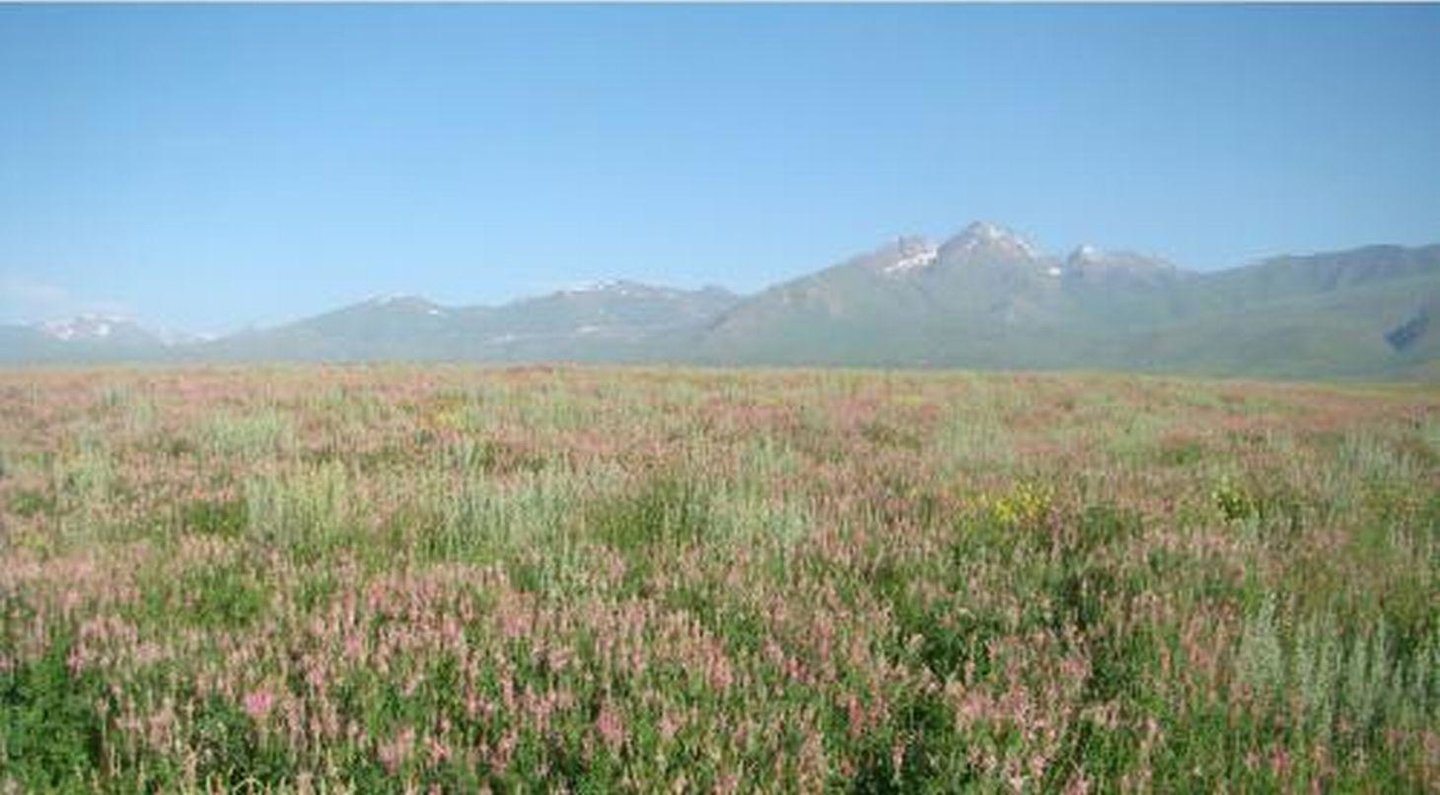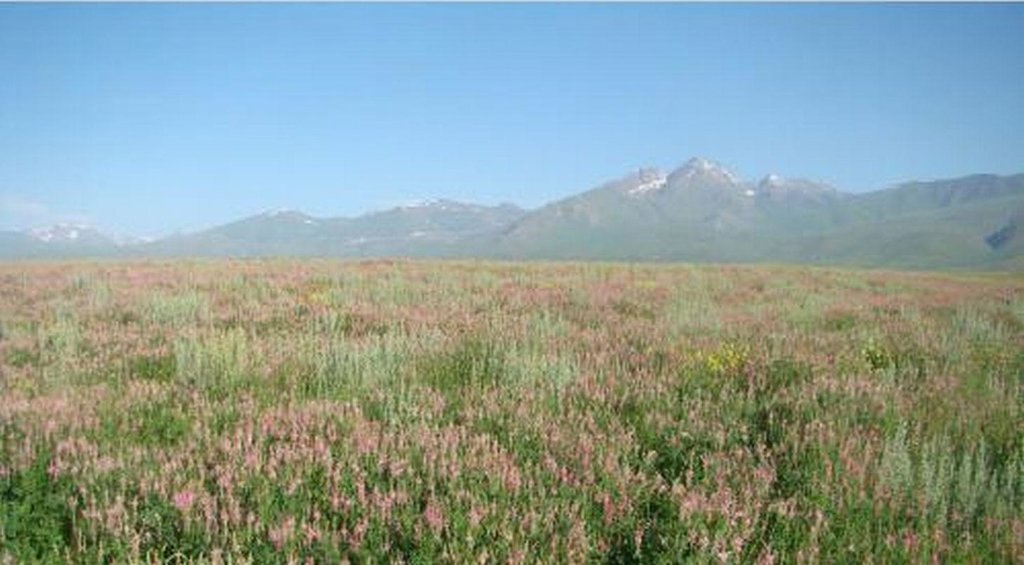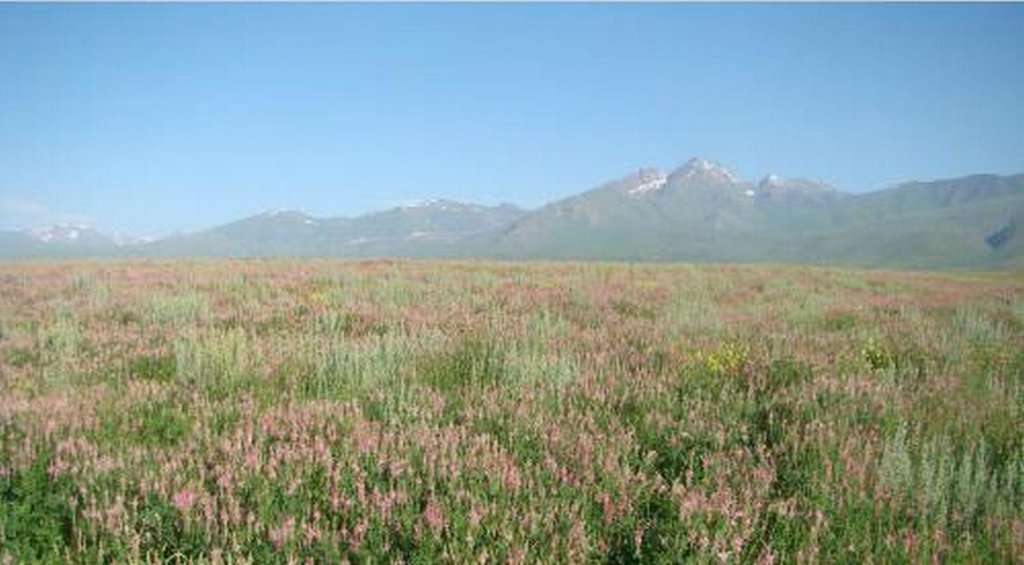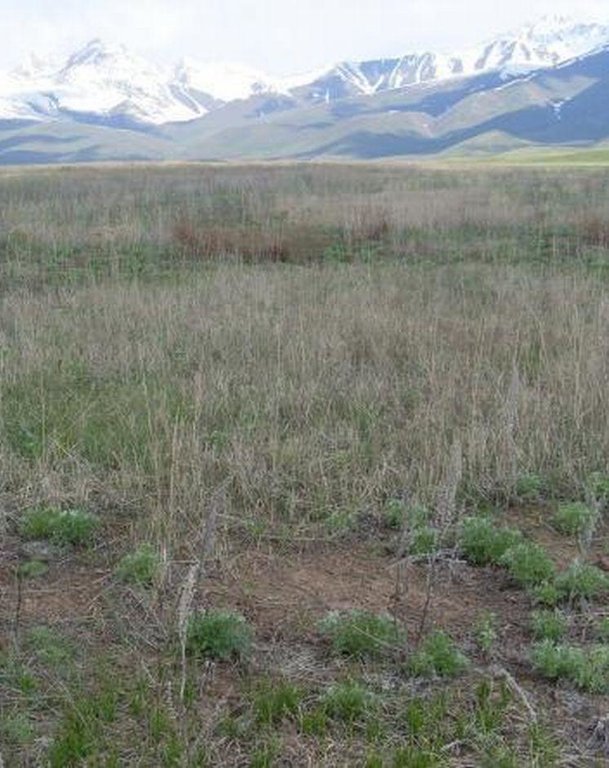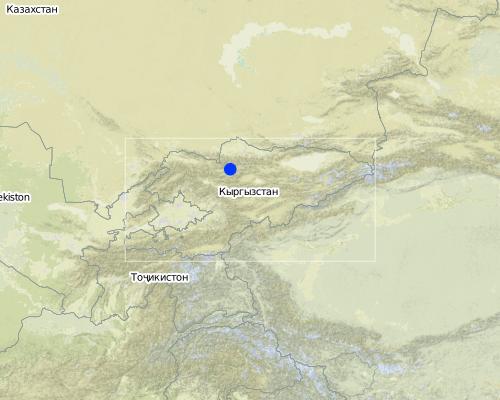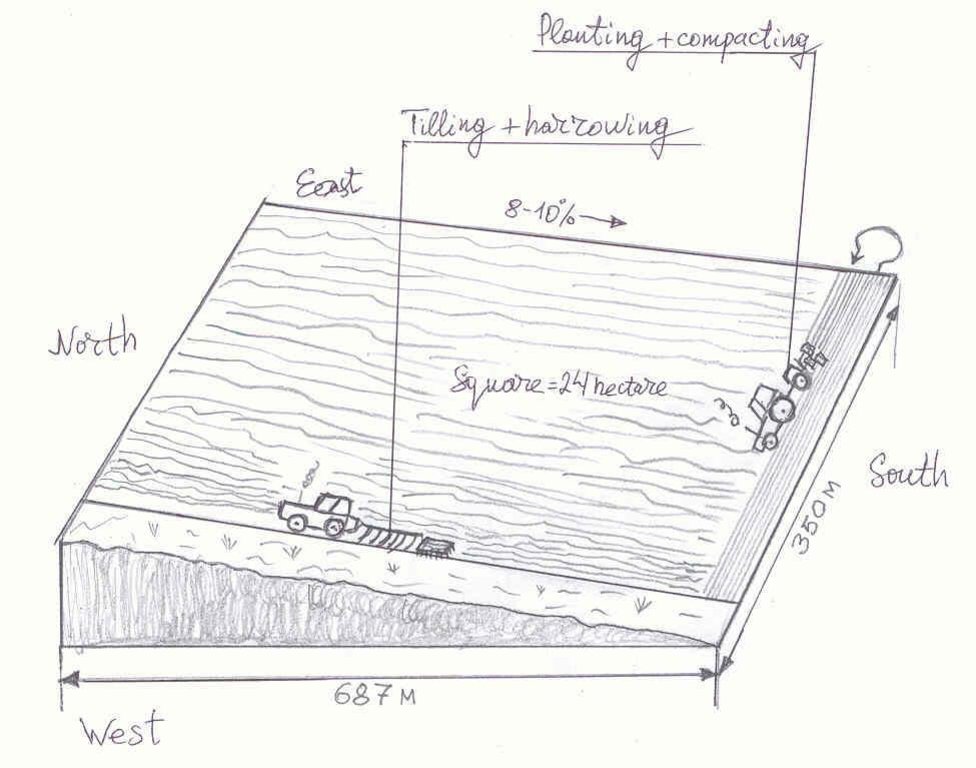Cultivation of sainfoin on high mountain pastures – Suusamyr Valley (in the frame of CACILM) [Kirguistán]
- Creación:
- Actualización:
- Compilador: Abdybek Asanaliev
- Editor: –
- Revisores: Alexandra Gavilano, Deborah Niggli
Kyrgyzstan - Central Asian Countries Initiative for Land Management (CACILM/ИСЦАУЗР)
technologies_963 - Kirguistán
- Resumen completo en PDF
- Resumen completo en PDF para imprimir
- Resumen completo en el navegador
- Resumen completo (sin formato)
- Cultivation of sainfoin on high mountain pastures – Suusamyr Valley (in the frame of CACILM): 27 de diciembre de 2016 (inactive)
- Cultivation of sainfoin on high mountain pastures – Suusamyr Valley (in the frame of CACILM): 21 de marzo de 2017 (inactive)
- Cultivation of sainfoin on high mountain pastures – Suusamyr Valley (in the frame of CACILM): 3 de agosto de 2017 (public)
Visualizar secciones
Expandir todo Colapsar todos1. Información general
1.2 Detalles de contacto de las personas de referencia e instituciones involucradas en la evaluación y la documentación de la Tecnología
Persona(s) de referencia clave
usuario de la tierra:
Ibraimov Azimjan
Farmer in Susamyr valley
Kirguistán
usuario de la tierra:
Usubaliev Baibek
996 (312) 566 318
b.usubaliev@up.elcat.kg
ELCAT
Toktanaliev Street, # 4 A, room # 212,
Kirguistán
usuario de la tierra:
Duishenaaly uulu Urmat
Suusamyr Village
Kirguistán
Nombre del proyecto que financió la documentación/ evaluación de la Tecnología (si fuera relevante)
Central Asian Countries Initiative for Land Management (CACILM I)1.3 Condiciones referidas al uso de datos documentados mediante WOCAT
¿Cuándo se compilaron los datos (en el campo)?
14/01/2011
El compilador y la/s persona(s) de referencia claves aceptan las condiciones acerca del uso de los datos documentados mediante WOCAT:
Sí
1.4 Declaración de la sostenibilidad de la Tecnología descrita
¿La Tecnología aquí descrita resulta problemática en relación a la degradación de la tierra, de tal forma que no puede considerársela una tecnología sostenible para el manejo de la tierra?
No
2. Descripción de la Tecnología MST
2.1 Breve descripción de la Tecnología
Definición de la Tecnología:
Conservation of soil fertility through the cultivation of sainfoin (perennial legume plants)
2.2 Descripción detallada de la Tecnología
Descripción:
The Suusamyr Plain is located in the South-West of Chui Valley. Generally, this zone, located at 2000-3800 meters above sea level is used by farmers as summer pastures. Farmers are practicing agro-pastoralism by grazing animals and at the same time producing winter fodder for their livestock. They cultivate mainly barley and sometimes perennial grass.
The territory of the local administration of the Aiyl Okrug “Suusamyr” includes 6645 hectares of arable land. In 2009 about 2500 hectares were cultivated with cereals (including 1950 ha of barley) and 250 ha with sainfoin. As a result of the monoculture of cereals, weeds, pests, and insects accumulate on the fields and the soil fertility is declining. These are direct and indirect indicators of soil degradation.
The main cultivated perennial legume is sainfoin. However,farmers are short of sainfoin seeds. Most of them cultivate sainfoin for hay making and consider the seed production as non profitable.
Fallow is maintained free from weed during the vegetation season. As fallow is weed free and accumulates the soil moisture it has synergy effect to harvest high yield of barley grain. This fallow is kept during one vegetation season and applied by other farmers during next season. Crop rotation cycle is 5 years including 1 year-fallow period (1year-fallow period, 1year for barley planting and 3 years for sainfoin planting). Barley is planted into the fallow.
Sainfoin improves the soil structure as a result of high rizo-biomasses (237-333 kg/ha). Sainfoin is able to accumulate 194 -178 kg/ha of biological nitrogen providing sufficient nitrogen fertilization for two consecutive cropping seasons. Sainfoin can be cultivated at altitudes from 700 to 3400 m above sea level (G. Balian, 2004). Sainfoin is a high nectar producting crop, allowing farmers to produce 150 kg of honey from 1 hectare of sainfoin during a vegetation period. As the result of insect pollination, an increase in seed production of between 100 and 200 kg/ha has been observed.
Purpose of the Technology: Soil fertility conservation through crop rotation of barley with the perennial grass sainfoin (Onobrichis sativa).
Farmer Ibraimov Azimjan has 25 hectares of private land and rents other land from neighboring farmers. UNDP’s project procured seeds of sainfoin and covered expenditures for tillage and planting. The farmer’s responsibility is to distribute produced seeds among other farmers which are able to expand their areas under sainfoin cultivation. The farmers maintains crop rotation.
Fields are located in the foothills at an elevation of 2038-2200 m above sea level. Plowing is conducted along the slope. But planting is done across to the tilling direction, horizontally along the field (contour planting drilling). This technology increases vegetation cover and after harvesting stubbles remain
Agriculture in Suusamyr Valley is based on animal husbandry which is kept on pastures during three seasons (spring, summer and autumn). But farmers practice agro-pastorals. They have private arable land and produce cereals and forage crops. The Local Government “Suusamyr” has 6645 hectares of arable land including 561 hectares from the Distribution Found (state regulated land). Farmers are not subsidized by the Government.
The farmer Ibraimov Azimjan has 25 hectares of private land and rents other land from the neighboring farmers. In 2009 UNDP’s project procured basic seeds of sainfoin and covered the expenditures for tillage and planting. UNDP’s project organized several workshops for farmers on technology of cereals and forage crops cultivation. Project manager also had finance support in field inspection of sainfoin seed and barley.
Farmer’s responsibility is to distribute seed among other farmers which able to expand their areas under sainfoin. Farmer has resources to guard the field from grazing of animals during the vegetation period, harvest and transportation of seed. Azimjan also organized the seed cleaning and storage. Project’s management developed the rules on seed distributions and sale.
The farmer should produce sainfoin and barley in order to get benefit. Farmer’s responsibility is to distribute seed to other farmers which able to expand the area under sainfoin and barley. Name of sainfoin variety is “Belek”, barley variety is “Kylym”, they are developed in research centers of Kyrgyz Republic.
The population of the Aiyl Okrug “Suusamyr” is 6400. The Local Government has no human resources for field activities. There are six villages at the territory of this Local Government. All fields and villages are connected by dirt roads. The electricity is supplied on regularly basis. People have drinking water supplies.
Farmer’s fields are located at foothills of 2038-2200 m above sea level. The type of land use is rainfed. Some irrigated channels which were developed in Soviet time are destroyed now. The fields are infested mainly with wild Oat, Couch-grass, spp. pigweed, wormwood and others.
The farmers cultivate cereals as monoculture. Some of them plant the sainfoin. Additionally, farmers cultivate potato on a total area of 180-200 hectares. The varieties are from local breeders (Nevsky, Cardinal) and introduced varieties from seed Firm “Agrico” and “NZPC” (Picasso, Sante and Mondial).
The main type of soil is chestnut (light chestnut soil and dark chestnut soil). The potential fertility of these soils is high but due to the lack of crop rotation, plant protection activities, fertilizer application, soil degradation is going on. There are no soil maps in the office of local administration except for those which were developed during the Soviet time.
2.3 Fotografías de la Tecnología
2.5 País/ región/ lugares donde la Tecnología fue aplicada y que se hallan comprendidos por esta evaluación
País:
Kirguistán
Región/ Estado/ Provincia:
Kyrgyz Republic, Chui oblast
Especifique más el lugar :
Jayl district
Comentarios:
Boundary points of the Technology area: The sainfoin is cultivated on mountain pastures from 800 meters to 3000 meters above sea level
Map
×2.6 Fecha de la implementación
Si no se conoce el año preciso, indique la fecha aproximada:
- hace menos de 10 años (recientemente)
2.7 Introducción de la Tecnología
Especifique cómo se introdujo la Tecnología:
- mediante proyectos/ intervenciones externas
Comentarios (tipo de proyecto, etc.):
The Technology was developed by the Kyrgyz Livestock and Pasture Research Institute and applied by the UNDP Project "Demonstration Sustainable Mountain Pasture Management in Suusamyr Valley, Kyrgyzstan"
3. Clasificación de la Tecnología MST
3.1 Propósito(s) principal(es) de la Tecnología MST
- crear impacto económico benéfico
3.2 Tipo(s) actuales de uso de la tierra donde se aplica la Tecnología

Tierras cultivadas
- Cosecha anual
- Cultivos perennes (no leñosos)

Tierra de pastoreo
Tierras de pastoreo extensivo:
- Semi-nomadismo/ pastoralismo
- Ganadería de hacienda
Pastoreo intensivo/ producción de forraje:
- Pastoreo mejorado
- agro-pastoralism
Comentarios:
Major land use problems (compiler’s opinion): Decline of soil fertility due to longstanding cultivation of barley on the field. Annual conventional plowing is affecting the mineralization of soil humus.
Major land use problems (land users’ perception): Decline of barley yield. The quality of barley grain also is declining.
Future (final) land use (after implementation of SLM Technology): Cropland: Cp: Perennial (non-woody) cropping
Livestock is grazing on crop residues
3.3 Información adicional sobre el uso de tierras
Provisión de agua para la tierra donde se aplica la Tecnología:
- mixta de secano – irrigada
Número de temporadas de cultivo por año:
- 1
Especifique:
Longest growing period in days: 120, Longest growing period from month to month: April - August
Densidad del ganado (si fuese relevante):
25-50 LU /km2
3.5 Difusión de la Tecnología
Especifique la difusión de la Tecnología:
- distribuida parejamente sobre un área
Si la tecnología se halla difundida homogéneamente en un área, indique el área aproximada que cubre:
- 0.1-1 km2
Comentarios:
Total area covered by the SLM Technology is 0,24 m2.
3.6 Medidas MST que componen la Tecnología

medidas agronómicas
- A1: vegetación/ cubierta del suelo
- A3: Tratamiento de superficie del suelo

medidas vegetativas
- V2: Pastos y plantas herbáceas perennes
3.7 Principales tipos de degradación de la tierra encarados con la Tecnología

deterioro químico del suelo
- Cn: reducción de la fertilidad y contenido reducido de la materia orgánica del suelo (no ocasionados por la erosión)

degradación biológica
- Bc: reducción de la cobertura vegetal del suelo
- Bh: pérdida de hábitats
Comentarios:
Main causes of degradation: soil management (Lack of fertilizes), over-exploitation of vegetation for domestic use, Heavy / extreme rainfall (intensity/amounts) (Usually in dry weather plants have a vertical appearance. After heavy gales they lose their vetical standing and they droop. This is lodging. During lodginh of plants the yield of seed is decreasing.), land tenure
Secondary causes of degradation: crop management (annual, perennial, tree/shrub) (As a result of the monoculture of cereals, weeds, pests, and insects accumulate on the fields and the soil fertility is declining.), other human induced causes (specify) (inappropriate soil management)
3.8 Prevención, reducción o restauración de la degradación de la tierra
Especifique la meta de la Tecnología con relación a la degradación de la tierra:
- reducir la degradación de la tierra
- restaurar/ rehabilitar tierra severamente degradada
4. Especificaciones técnicas, actividades de implementación, insumos y costos
4.1 Dibujo técnico de la Tecnología
4.2 Especificaciones técnicas/ explicaciones del dibujo técnico
Fields are located on South exposition of the foothills of the Kyrgyz Ala-Too Mountains in the Northern part of the Suusamyr valley. The length of the sainfoin field is 687 meters, and its width is 350 meters. Slope steepness is 8-10 %.
Tilling is conducted along the slope by a tractor K-700, with harrowing being conducted at the same time. The depth of tilling is 20-22 cm. Planting is conducted across to plowing direction. The date for sainfoin sowing is the first ten days of May. The seeds required are 80 kg/ha. Depth of sowing is 4 cm. This field is situated 8 kilometers from central Suusamyr village, reachable on a bad dirt road.
Location: Suusamyr Valley. Jaiyl raion / Chui oblast / Kyrgyzstan
Date: 11.01.2011
Technical knowledge required for field staff / advisors: high (Special training is requested)
Technical knowledge required for land users: low (Field demonstration is needed)
Main technical functions: control of dispersed runoff: impede / retard, stabilisation of soil (eg by tree roots against land slides), increase in organic matter, increase in nutrient availability (supply, recycling,…)
Secondary technical functions: improvement of subsoil structure (hardpan)
Vegetative measure: field planted by perennual grass
Vegetative material: C : perennial crops
Number of plants per (ha): 3000000
Spacing between rows / strips / blocks (m): 0.15
Width within rows / strips / blocks (m): 0.15
Vegetative measure: Vegetative material: C : perennial crops
Perennial crops species: Sainfoin os sowed with planting machine C3-3.6. The distance between colters is 15 cm.
4.3 Información general sobre el cálculo de insumos y costos
otra / moneda nacional (especifique):
KGS
Indique la tasa de cambio de USD a la moneda local (si fuese relevante): 1 USD =:
45,0
Indique el costo promedio del salario de trabajo contratado por día:
8.00
4.4 Actividades de establecimiento
| Actividad | Tipo de medida | Momento | |
|---|---|---|---|
| 1. | Tilling | Vegetativas | End of April. Once in 3 years |
| 2. | Planting | Vegetativas | End of April. Once in 3 years |
4.5 Costos e insumos necesarios para el establecimiento
| Especifique insumo | Unidad | Cantidad | Costos por unidad | Costos totales por insumo | % de los costos cubiertos por los usuarios de las tierras | |
|---|---|---|---|---|---|---|
| Mano de obra | establishment costs | hectare | 1,0 | 187,0 | 187,0 | |
| Mano de obra | labour | person/hour | 0,8 | 128,0 | 102,4 | 100,0 |
| Material para plantas | seeds | hecatre | 1,0 | 108,0 | 108,0 | |
| Material para plantas | seeds | kg | 75,0 | 2600,0 | 195000,0 | |
| Otros | fuel | liter | 58,0 | 321,0 | 18618,0 | |
| Costos totales para establecer la Tecnología | 214015,4 | |||||
Comentarios:
Duration of establishment phase: 1 month(s)
4.6 Actividades de establecimiento/ recurrentes
| Actividad | Tipo de medida | Momento/ frequencia | |
|---|---|---|---|
| 1. | Harvesting | Vegetativas | annually |
| 2. | Cleaning of seed | Vegetativas | annually |
| 3. | Cleaning of seed | Vegetativas |
4.7 Costos e insumos necesarios para actividades de mantenimiento/ recurrentes (por año)
Comentarios:
Machinery/ tools: Tractor MTZ-80, Self-Proppeled Combine Enisey-600, Seed Cleaning Machine SM-4
The above costs were affected by the length of the field and number of turn points during tilling and planting.
4.8 Factores más determinantes que afectan los costos:
Describa los factores más determinantes que afectan los costos:
The price of sainfoin seeds is very high. The slope is increasing the fuel consumption of the tractor, and prices for fuel are raising. Contour tilling (also planting) by big tractor (K-700) is further increasing fuel consumption, because the number of turning-points are increased. Soil depth is not increasing cost in a major way, because soil structure in the area is comparatively good and the tractor is powerful.
All costs are calculated for 1 hectare of sainfoin. National currency is KGS. Exchange rate was approximately 45 KGS for 1 US Dollar in 2009 and 2010.
5. Entorno natural y humano
5.1 Clima
Lluvia anual
- < 250 mm
- 251-500 mm
- 501-750 mm
- 751-1,000 mm
- 1,001-1,500 mm
- 1,501-2,000 mm
- 2,001-3,000 mm
- 3,001-4,000 mm
- > 4,000 mm
Zona agroclimática
- Sub-húmeda
Thermal climate class: temperate
5.2 Topografía
Pendientes en promedio:
- plana (0-2 %)
- ligera (3-5%)
- moderada (6-10%)
- ondulada (11-15%)
- accidentada (16-30%)
- empinada (31-60%)
- muy empinada (>60%)
Formaciones telúricas:
- meseta/ planicies
- cordilleras
- laderas montañosas
- laderas de cerro
- pies de monte
- fondo del valle
Zona altitudinal:
- 0-100 m s.n.m.
- 101-500 m s.n.m.
- 501-1,000 m s.n.m
- 1,001-1,500 m s.n.m
- 1,501-2,000 m s.n.m
- 2,001-2,500 m s.n.m
- 2,501-3,000 m s.n.m
- 3,001-4,000 m s.n.m
- > 4,000 m s.n.m
5.3 Suelos
Profundidad promedio del suelo:
- muy superficial (0-20 cm)
- superficial (21-50 cm)
- moderadamente profunda (51-80 cm)
- profunda (81-120 cm)
- muy profunda (>120 cm)
Textura del suelo (capa arable):
- áspera/ ligera (arenosa)
- mediana (limosa)
Textura del suelo (> 20 cm debajo de la superficie):
- áspera/ ligera (arenosa)
- mediana (limosa)
Materia orgánica de capa arable:
- elevada (>3%)
- media (1-3%)
Si se halla disponible, adjunte una descripción completa de los suelos o especifique la información disponible, por ej., tipo de suelo, pH/ acidez de suelo, capacidad de intercambio catiónico, nitrógeno, salinidad, etc. :
medium-high soil fertility, soil water storage = medium, soil drainage = good
5.4 Disponibilidad y calidad de agua
Agua subterránea:
5-50 m
Disponibilidad de aguas superficiales:
bueno
Calidad de agua (sin tratar):
agua potable de buena calidad
¿La salinidad del agua es un problema?
No
5.5 Biodiversidad
Diversidad de especies:
- mediana
Diversidad de hábitats:
- mediana
Comentarios y especificaciones adicionales sobre biodiversidad:
Earthworms and gnawing animals inhabit on the field
5.6 Las características de los usuarios de la tierra que aplican la Tecnología
Sedentario o nómada:
- Semi-nómada
- Nómada
Orientación del mercado del sistema de producción:
- subsistencia (autoprovisionamiento)
- mixta (subsistencia/ comercial)
Ingresos no agrarios:
- menos del 10% de todos los ingresos
Nivel relativo de riqueza:
- promedio
- muy rico
Individuos o grupos:
- grupos/ comunal
Nivel de mecanización:
- mecanizado/motorizado
Género:
- mujeres
- hombres
Indique otras características relevantes de los usuarios de las tierras:
Land users applying the Technology are mainly common / average land users
Difference in the involvement of women and men: This technology is very strongly supported by Pasture Users Association, who is interesting in improving forage quantity and quality. Sainfoin's hay has high protein content in comparison with natural hay. Therefore the association is interested in expansion of sainfoin fields.
Population density: < 10 persons/km2
Annual population growth: 1% - 2%
Off-farm income specification: Some farmers sell agricultural and processing products in the shops located along the highway Bishkek-Osh and in the villages. Some of the villagers provide taxi services from Suusamyr to Bishkek.
5.7 Área promedio de la tierra que pertenece a o es arrendada por usuarios de tierra que aplican la Tecnología
- < 0.5 ha
- 0.5-1 ha
- 1-2 ha
- 2-5 ha
- 5-15 ha
- 15-50 ha
- 50-100 ha
- 100-500 ha
- 500-1,000 ha
- 1,000-10,000 ha
- > 10,000 ha
¿Esto se considera de pequeña, mediana o gran escala (refiriéndose al contexto local)?
- escala mediana
5.8 Tenencia de tierra, uso de tierra y derechos de uso de agua
Tenencia de tierra:
- estado
- individual, con título
Derechos de uso de tierra:
- individual
Derechos de uso de agua:
- comunitarios (organizado)
5.9 Acceso a servicios e infraestructura
salud:
- pobre
- moderado
- bueno
educación:
- pobre
- moderado
- bueno
asistencia técnica:
- pobre
- moderado
- bueno
empleo (ej. fuera de la granja):
- pobre
- moderado
- bueno
mercados:
- pobre
- moderado
- bueno
energía:
- pobre
- moderado
- bueno
caminos y transporte:
- pobre
- moderado
- bueno
agua potable y saneamiento:
- pobre
- moderado
- bueno
servicios financieros:
- pobre
- moderado
- bueno
Extension Service:
- pobre
- moderado
- bueno
6. Impactos y comentarios para concluir
6.1 Impactos in situ demostrados por la Tecnología
Impactos socioeconómicos
Producción
producción de cultivo
Cantidad antes de MST:
19 c/ha
Cantidad luego de MST:
23 c/ha
producción de forraje
Cantidad antes de MST:
500 bales
Cantidad luego de MST:
550 bales
calidad de forraje
Ingreso y costos
gastos en insumos agrícolas
Cantidad antes de MST:
0
Cantidad luego de MST:
24 ha
diversidad de fuentes de ingreso
Impactos socioculturales
seguridad alimentaria/ autosuficiencia
oportunidades culturales
instituciones comunitarias
Cantidad antes de MST:
0
Cantidad luego de MST:
1
mitigación de conflicto
Cantidad antes de MST:
0
Cantidad luego de MST:
2 training
Impactos ecológicos
Ciclo de agua/ escurrimiento de sedimento
escurrimiento superficial
Suelo
cubierta del suelo
Cantidad antes de MST:
80%
Cantidad luego de MST:
95%
compactación de suelo
materia orgánica debajo del suelo C
Biodiversidad: vegetación, animales
diversidad de hábitats
6.2 Impactos fuera del sitio demostrados por la Tecnología
capacidad de amortiguación/ filtrado
daño a campos de vecinos
Cantidad luego de MST:
5ha
Comentarios/ especifique:
Project recruts a security guard to protect sainfoin field since May. And at the same time he watches the neighbours fields.Therefore damage on it is reduced.
Honey collection is improved
6.3 Exposición y sensibilidad de la Tecnología al cambio climático gradual y a extremos relacionados al clima/ desastres (desde la percepción de los usuarios de tierras)
Cambio climático gradual
Cambio climático gradual
| Estación | tipo de cambios climáticos/ climas extremos | ¿Cómo es que la tecnología soporta esto? | |
|---|---|---|---|
| temperatura anual | incrementó | no muy bien |
Extremos (desastres) relacionados al clima
Desastres climatológicos:
| ¿Cómo es que la tecnología soporta esto? | |
|---|---|
| tormenta de lluvia local | bien |
Desastres climatológicos
| ¿Cómo es que la tecnología soporta esto? | |
|---|---|
| sequía | bien |
Desastres hidrológicos
| ¿Cómo es que la tecnología soporta esto? | |
|---|---|
| inundación general (río) | no muy bien |
Otras consecuencias relacionadas al clima
Otras consecuencias relacionadas al clima
| ¿Cómo es que la tecnología soporta esto? | |
|---|---|
| periodo reducido de crecimiento | no muy bien |
6.4 Análisis costo-beneficio
¿Cómo se comparan los beneficios con los costos de establecimiento (desde la perspectiva de los usuarios de tierra)?
Ingresos a corto plazo:
muy positivo
Ingresos a largo plazo:
muy positivo
¿Cómo se comparan los beneficios con los costos de mantenimiento/ recurrentes (desde la perspectiva de los usuarios de tierra)?
Ingresos a corto plazo:
positivo
Ingresos a largo plazo:
positivo
6.5 Adopción de la Tecnología
- casos individuales / experimentales
De todos quienes adoptaron la Tecnología, ¿cuántos lo hicieron espontáneamente, es decir, sin recibir incentivos/ pagos materiales?
- 0-10%
Comentarios:
1% of land user families have adopted the Technology with external material support
1 land user families have adopted the Technology with external material support
Comments on acceptance with external material support: Saifoin seed was provided to farmers with lower price than commercially available seeds.
Comments on spontaneous adoption: There is little trend towards (growing) spontaneous adoption of the technology.
There is a little trend towards spontaneous adoption of the Technology. Some farmers are aware about the production of high quality forage and want to be ready to be protected from drought. During drought periods the yield of natural vegetation is less, but the yield of sainfoin’ is constant.
6.7 Fuerzas/ ventajas/ oportunidades de la Tecnología
| Fuerzas/ ventajas/ oportunidades desde la perspectiva del usuario de la tierra |
|---|
| Keeping the fields as fallow is not profitable for ordinary farmers. It can be done by rich farmers. |
| There is need in subsidies from the Government in order to distribute cereals and perennial legume seed. |
| If there is enough fuel and seed farmers can cultivate sainfoin everywhere, it is very good technology. |
| Fuerzas/ ventajas/ oportunidades desde la perspectiva del compilador o de otra persona de referencia clave |
|---|
| The winter is very hard in Suusamyr Valley and livestock need enough and quality forage. Sainfoin hay contains high level of protein. |
| Natural vegetation yields for hay making is not so big particularly in drought period. Sainfoin is very productive crop. |
| Rizo biomass of sainfoin is big and it accumulates the nitrogen. Sainfoin improves the soil fertility. |
| Sainfoin is income generating crop because after harvesting of seed sainfoin the straw can be also sold by farmers at the price of 50 som for one hay bale |
| This Technology also protects the soil surface from the erosion in the result of strong density of plants. |
6.8 Debilidades/ desventajas/ riesgos de la Tecnología y formas de sobreponerse a ellos
| Debilidades/ desventajas/ riesgos desde la perspectiva del usuario de la tierra | ¿Cómo sobreponerse a ellas? |
|---|---|
| Poor farmer is not interested in the Conservation Technology | Awareness raising of the poor farmers is necessary |
| We are having not enough knowledge about the soil conservation possibility legumes | To organize the training of farmers. |
| State legislation about soil protection is not maintained by Local Government and farmers | To monitor the observation of legislation by land users and local authorities |
| There should be Soil fertility protection service. | The Government should finance the establishment of service on soil fertility protection. |
| Debilidades/ desventajas/ riesgos desde la perspectiva del compilador o de otra persona de referencia clave | ¿Cómo sobreponerse a ellas? |
|---|---|
| Lack of good credit system for farmers SWCT. | To lower interest rates of credits while lending farmers for implementation of the Conservation Technology |
| Comparatively high price of certified sainfoin seeds are not available for farmers | Usage of not certified seed by farmers leads to poor yields of sainfoin and cereals. To ensure the supply of high quality seed through distributers’ centers |
| Farmers need special knowledge in order to produce sainfoin seed | To conduct trainings for farmers on seed production technologies. |
|
To consolidate farmers about the effect of sainfoin cultivation for soil fertility some scientists have to do on farm demonstration plots |
Extension services should organize demonstration fields in villages. |
7. Referencias y vínculos
7.1 Métodos/ fuentes de información
- visitas de campo, encuestas de campo
- entrevistas con usuarios de tierras
7.2 Vínculos a las publicaciones disponibles
Título, autor, año, ISBN:
Usubaliev B. Annual project activity’s report. “Demonstration sustainable mountains pasture management in the Suusamyr Valley. Kyrgyzstan”. UNDP.- Kyrgyzsran., 2010. Bishkek.
¿Dónde se halla disponible? ¿Costo?
Project office
Título, autor, año, ISBN:
Duishenaaly uulu Urmat.- Report of land management specialist of the “Local Gogernment Suusamyr”, 2010
¿Dónde se halla disponible? ¿Costo?
Suusamyr Village
Título, autor, año, ISBN:
Bekganov Nurkan.- Report of local mobilization specialist of the UNDP project.- 2010
¿Dónde se halla disponible? ¿Costo?
Suusamyr Village.
Título, autor, año, ISBN:
Amankulov Kubanychbek.- Report of statistics specialist of the “Local Gogernment Suusamyr”, 2010
¿Dónde se halla disponible? ¿Costo?
.Suusamyr Village
Vínculos y módulos
Expandir todo Colapsar todosVínculos
No hay vínculos
Módulos
No se hallaron módulos


